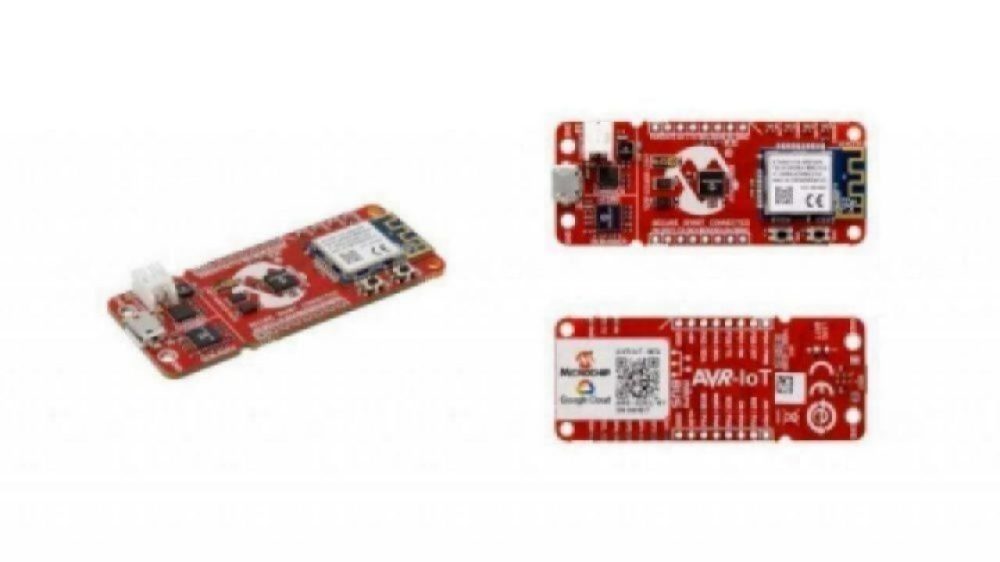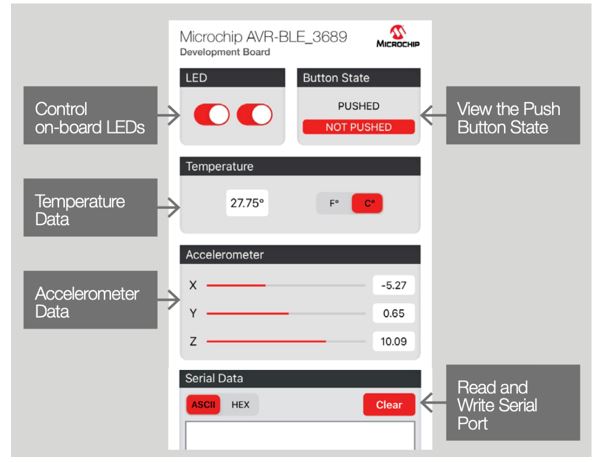IoT Design Gets Smart and Secure Embedded Solutions
Article By : M. Di Paolo Emilio

Microchip has launched a range of IoT solutions for rapid prototyping by using cloud connectivity for all integrated microcontroller solutions.
IoT design is characterized by pairing the appropriate microcontroller solutions with the ideal connection protocol for your application. Microchip Technology Inc. announced a line-up of full-stack, embedded development solutions that provide any number of such combinations. The line ranges from the smallest PIC and AVR microcontrollers (MCUs) for sensors and actuators, to 32-bit MCU gateway and microprocessor (MPU) solutions for edge computing. Connectivity options include Wi-Fi, Bluetooth or 5G narrowband technologies, all while maintaining a security foundation with support from its Trust Platform for the CryptoAuthentication family.
IoT design
Usually, the first step is to choose the ideal development kit for your prototype. Trying to build a cloud-connected IoT system from scratch can be a daunting task. It can be costly and time-consuming and requires expertise in many different engineering disciplines. Today’s developers face more challenges than ever in design decisions: longer development time, higher security threats.
IoT sensor networks and intelligent devices will be woven into virtually every aspect of our environment: our homes, physical objects, transportation and communication systems, clothing and the human body, enabling us to connect and exchange data. There are potential opportunities in the IoT, but it’s going to be hard to take advantage of them all unless workflows are simplified, and components are more modular.
For IoT applications, there could be three different types of projects:
- Cloud-connected projects: the cloud is built with servers that use dedicated software to analyze and process data collected by systems.
- Projects connected to a local network: they use an intranet network to communicate.
- Gateway projects: gateway systems are often used to adapt existing systems to the Internet.
Development kits and other prototyping platforms are proving vital to level the IoT supply chain, accelerate innovation, and stimulate anyone with the ideas and ambitions to design and create successful IoT solutions.
Microchip solutions
“We still see that the adoption rate of IoT is fairly slow,” said Oyvind Strom, marketing director at Microchip Technology. “There are many solutions out there, but we see a large customer base where not necessarily all of them are comfortable with IoT. What we have been doing is launching edge nodes and gateways where ease-of-use is in focus. “
The security hardware solutions help protect against security threats, ranging from remote cyber-attacks to the creation of counterfeit products.
Microchip offers a range of new, intelligent, connected, and secure rapid prototyping solutions. There are four new Wi-Fi development platforms for the Internet of things through the PIC platform and the AVR platform. And two new Bluetooth prototyping boards for the PIC and AVR product lines will expand the choice of IoT prototyping. In addition, a new IoT gateway solution with Amazon GreenGrass and Azure will complete the portfolio. The partnership with Sequans will also allow implementing new kit solutions for LTE-M and M/NB-IoT infrastructure connections.
Each solution is designed to focus on ease of use and rapid development for intelligent industrial, medical, consumer, agricultural, and retail applications with security in mind. The wide choice of connectivity technologies, combined with the full range of microcontroller and microprocessor performance and peripheral features, makes these solutions scalable in a wide range of markets.
“When the customer wants to develop an IoT solution, you can either do IoT without the cloud or you can do IoT with the cloud. And cloud computing is definitely one of the fastest-growing areas in the world. There are three major cloud companies. It’s Google, Amazon and Microsoft. We are partnered with all of them,” said Strom.
Microchip’s broad portfolio includes the following solutions designed to reduce project costs and development complexity. The PIC-IoT WA and AVR-IoT WA boards are two new PIC and AVR MCU development boards. They developed in collaboration with Amazon Web Services (AWS), which helps designers natively connect IoT sensor nodes to the AWS IoT Core service via Wi-Fi.
“When you buy this board, you basically plug it with the USB plug to your PC, and it will bring you to a dedicated web-page where you enter your Wi-Fi credentials, and you will literally stream data to the Amazon cloud within 30 seconds from plugging that board into your computer for the first time. And from that you can continue to develop your application with our comprehensive ecosystem around this board. It’s a very powerful board done with the most cost-efficient microcontrollers that you find in the industry, and it shows that you don’t need to go to 32-bit platforms to do edge node IoT.” Said Strom.
The two boards are supplied with a temperature sensor and a light sensor for demonstration purposes only. A microbus expansion socket allows adding more than 300 different sensors from click boards that we also support in our ecosystem (figure 1).
![Figure 1: PIC/AVR-IoT WA board [Source: Microchip]](/wp-content/uploads/sites/4/2020/04/figure-1-microchip.jpg)
The SAM-IoT WG board connects the Google Cloud IoT Core with the popular SAM-D21 Arm Cortex® M0+ 32-bit Microchip range of microcontrollers (Figure 2).
![Figure 2: SAM-IoT WG [Source: Microchip].](/wp-content/uploads/sites/4/2020/04/figure2-microchip-sam.jpg)
The Azure IoT SAM MCU-based Internet of Things development platform integrates the Azure IoT SDK and Azure IoT services with Microchip’s MPLAB X ecosystem of development tools. The card offers much more computing performance. In addition to transmitting your data, you can perform analysis by using artificial intelligence on the board.
“Predictive-maintenance type of applications, for instance, could be one. The board can also be used for vision. These kinds of high-end applications for the IoT nodes would be a suitable target for this platform,” said Strom.
In addition to Wi-Fi boards, there are many requests for the implementation of Bluetooth in the industrial sector. All types of maintenance and repair of industrial equipment today are performed with integrated Bluetooth. The service technician can read an error code and things like that from his tablet or phone to avoid having to act mechanically inside the machine.
The PIC-BLE and AVR-BLE boards are based on PIC and AVR microcontrollers for sensor node devices that connect to mobile devices for industrial, consumer, and security applications and the cloud via Bluetooth Low Energy (BLE) gateways.
To ensure that only authorized devices can connect to the embedded device, an on-boarded secure element IC complete the Root of Trust from the embedded device up to the Cloud.
![Figure 3: PIC/AVR-BLE board [Source: Microchip]](/wp-content/uploads/sites/4/2020/04/figure3-microchip-board.jpg)
An application from Google Play or the iPhone App Store called LightBlue can be downloaded (figure 4).

The main onboard sensors are temperature, light, and a three-axis accelerometer. It is possible to implement other external click board sensors and develop your custom application starting from LightBlue.
As long as you can take advantage of Wi-Fi and BLE, it would help if you always had a gateway solution. Wi-Fi could be the router you have at home, but if you want a closed network, you will also need to provide a gateway in your application.
The gateway solution with AWS IoT Greengrass is based on the latest Wireless System On Module (SOM), the ATSAMA5D27-WLSOM1, which integrates the SAMA5D2 MPU, the WILC3000 Wi-Fi combo module and Bluetooth fully powered by the high-performance MCP16502 power management integrated circuit (PMIC).
“These solutions are fully certified with the AWS Greengrass solution. Greengrass is Amazon’s solution where you have cloud computing locally on your node. This can have many advantages, including near real-time responses and the ability to operate even if your internet connection is down” said Strom
Another solution announced by Microchip in collaboration with Sequans is the LTE-M/NB-IoT Development Kit. It includes modules based on Sequans’ Monarch chips that enable coverage of IoT nodes and take advantage of the latest low-power 5G cellular technology.
The idea is that a gateway is again an obstacle for the customer. If you want to transmit data directly to the cloud, an LTE- M/NB-IoT solution is the way to go. Right now, large networks are starting to roll out their 5G networks, and with 5G, they will enable a huge amount of IoT nodes directly to mobile networks.
There are two standards in the world. There is one called LTE-M and another called NB-IoT. They are close but the different regions have different standards (Figure 5).
Sequans has 5G technology that can be used in the Americas, all European countries, and also Japan and China. With this solution, Microchip can serve customers around the world with LTE-M /NB-IoT technology and IoT technology, with all major networks around the globe.
![Figure 5: LTE or M/NB-IoT development kit [Source: Microchip].](/wp-content/uploads/sites/4/2020/04/figure5-LTE.jpg)
Microchip’s new IoT solutions are based on the company’s extensive ecosystem of development tools, focused on the MPLAB X Integrated Development Environment (IDE). Code generators such as the MPLAB X Code Configurator (MCC) automate and speed application code creation and customization for smaller PIC and AVR microcontrollers. At the same time, Harmony’s software libraries support all 32-bit solutions for microcontrollers and microprocessors.